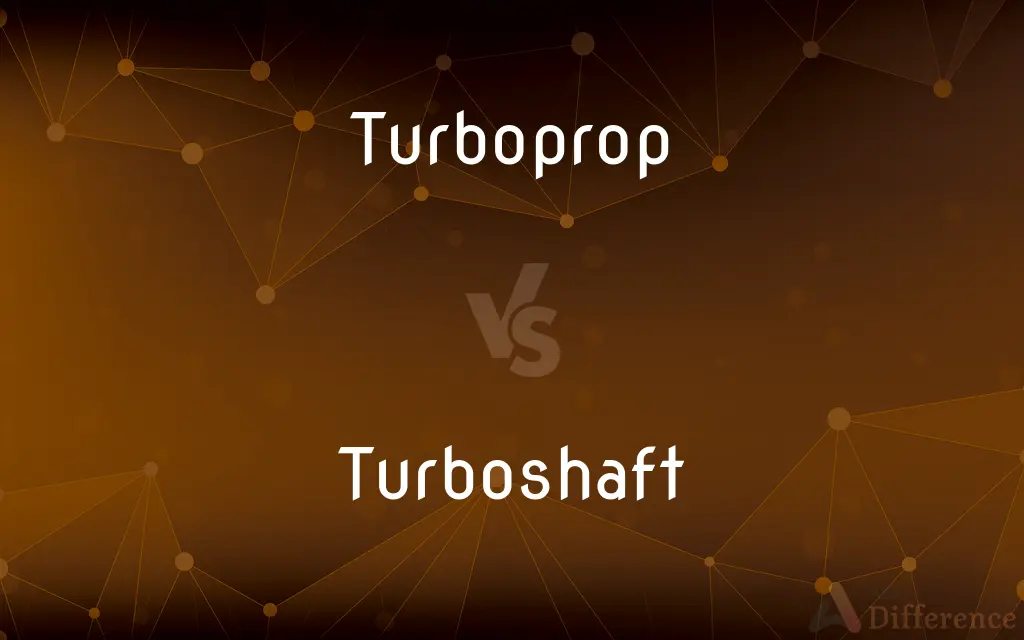Turboprop vs. Turboshaft — What's the Difference?
Edited by Tayyaba Rehman — By Fiza Rafique — Updated on March 26, 2024
Turboprop engines, designed to drive propellers for aircraft propulsion, offering efficiency at lower speed. Turboshaft engines transfer power to shaft used in helicopters or industrial machinery, optimized for power output rather than direct propulsion.

Difference Between Turboprop and Turboshaft
Table of Contents
ADVERTISEMENT
Key Differences
Turboprop engines are a type of gas turbine engine primarily used in aviation, especially in aircraft that fly at speeds below Mach 0.6. These engines combine the high-speed efficiency of jet engines with the fuel efficiency of propeller-driven aircraft by converting most of the engine's output into mechanical power to drive a propeller. On the other hand, turboshaft engines are also gas turbine engines but are designed to produce shaft power rather than thrust, which is used to drive machinery such as helicopters' rotors, tanks, and even power generators.
In turboprop engines, the propeller provides the majority of the thrust, with only a small portion coming from the exhaust gases. This makes them particularly efficient for short to medium-range flights at lower speeds and altitudes. Whereas turboshaft engines are optimized to deliver power to a rotor or other machinery, making them ideal for applications requiring high power-to-weight ratios and flexibility in power delivery, such as helicopters which need precise control over lift and thrust.
The design intricacies of turboprop engines focus on optimizing the balance between the jet thrust and the propeller's efficiency, leading to complex gearbox arrangements to manage engine and propeller speeds. Conversely, turboshaft engines are engineered for direct power delivery to a shaft, eliminating the need for such complex gear systems, which allows for more direct and efficient power transmission to the intended machinery.
Turboprop engines are favored in regional airliners, cargo planes, and military aircraft where fuel efficiency over short distances and the ability to take off and land from shorter runways are paramount. Turboshaft engines, due to their power efficiency and versatility, are preferred in helicopters for their ability to provide stable and adjustable power for both lift and propulsion, as well as in various industrial applications where compact, high-power engines are required.
Both engine types share the basic principles of gas turbine operation but are tailored for specific roles. Turboprops are about propelling aircraft efficiently at lower speeds and altitudes, benefiting from the efficiency of a propeller. Turboshafts, however, focus on providing high power output for driving a shaft, offering versatility and efficiency in power delivery for a wide range of applications beyond aviation, including marine and industrial uses.
ADVERTISEMENT
Comparison Chart
Primary Use
Driving propellers for aircraft propulsion.
Powering a shaft for helicopters or machinery.
Efficiency
High at lower speeds and altitudes.
Optimized for power-to-weight ratio and versatility.
Design Focus
Balancing jet thrust and propeller efficiency.
Direct power delivery to a shaft.
Application Examples
Regional airliners, cargo planes, military aircraft.
Helicopters, tanks, power generators.
Thrust Source
Majority from propeller, minority from exhaust.
N/A, focuses on power output to a shaft.
Gearbox Complexity
Complex, to manage engine and propeller speeds.
Less complex, focused on efficient power transmission.
Speed and Altitude
Efficient below Mach 0.6 and at lower altitudes.
Not directly related to speed; more about power delivery.
Preferred Environments
Short to medium-range flights, shorter runways.
Vertical lift applications, variable power needs.
Compare with Definitions
Turboprop
A gas turbine engine that drives a propeller for aircraft propulsion.
The ATR 72 uses turboprop engines for efficient regional flights.
Turboshaft
A gas turbine engine optimized to drive a shaft for various applications.
Helicopters use turboshaft engines for their rotors.
Turboprop
Used in regional airliners and cargo planes.
Military transport planes often use turboprop engines for their versatility and efficiency.
Turboshaft
Focuses on power delivery to machinery rather than thrust.
Turboshaft engines power the M1 Abrams tank.
Turboprop
Efficient at lower speeds and altitudes.
Turboprops excel in operations from airports with short runways.
Turboshaft
Offers high power-to-weight ratios.
Compact yet powerful, turboshafts are ideal for helicopters.
Turboprop
Provides thrust mainly through a propeller.
Despite having a jet engine, turboprops use the propeller for the majority of thrust.
Turboshaft
Versatile applications beyond aviation.
Some ships utilize turboshaft engines for propulsion systems.
Turboprop
Combines jet engine speed with propeller efficiency.
Turboprops are chosen for their fuel efficiency on short-haul routes.
Turboshaft
Eliminates the need for complex gearbox systems.
Power generation units use turboshafts for direct energy production.
Turboprop
A turboprop engine is a turbine engine that drives an aircraft propeller.A turboprop consists of an intake, reduction gearbox, compressor, combustor, turbine, and a propelling nozzle. Air is drawn into the intake and compressed by the compressor.
Turboshaft
A turboshaft engine is a form of gas turbine that is optimized to produce shaftpower rather than jet thrust. In concept, turboshaft engines are very similar to turbojets, with additional turbine expansion to extract heat energy from the exhaust and convert it into output shaft power.
Turboprop
A turbojet engine used to drive an external propeller.
Turboshaft
A gas turbine engine that powers a rotating cylindrical shaft, as to a pump or a helicopter rotor.
Turboprop
An aircraft in which a turboprop is used. Also called propjet.
Turboshaft
A gas-turbine engine designed to transmit power by means of a geared shaft, used in helicopters and for land and marine vehicular and stationary applications.
Turboprop
(aeronautics) A type of gas turbine aircraft engine that drives and obtains essentially all thrust from an external (typically unducted) propeller.
Turboprop
(aviation) An aircraft that uses a turboprop engine.
Turboprop
Airplane powered by a turbojet engine
Turboprop
An airplane with an external propeller that is driven by a turbojet engine
Common Curiosities
Why are turboprop engines efficient for short to medium-range flights?
They combine the efficiency of a propeller at lower speeds and altitudes with the power of a jet engine, making them ideal for such flights.
How do turboprop and turboshaft engines manage power?
Turboprops use complex gearboxes to balance engine and propeller speeds for efficient thrust, while turboshafts directly transmit power to a shaft, eliminating the need for such complexity.
What is the main difference between a turboprop and a turboshaft engine?
The main difference lies in their application: turboprops are used for propelling aircraft via a propeller, while turboshafts provide power to a shaft for driving helicopters' rotors or other machinery.
How does the efficiency of turboprop engines compare at high speeds?
Turboprop engines lose efficiency at high speeds compared to jet engines, making them less suitable for high-speed air travel.
How do the operational costs of turboprop and turboshaft engines compare?
Operational costs can vary based on application and design, but turboprops generally offer lower costs for aviation purposes, especially in short to medium-range flights, due to their fuel efficiency.
What are the environmental impacts of turboprop vs. turboshaft engines?
Both engine types have been subject to advancements aimed at reducing emissions and noise. Turboprops, being more commonly used in commercial aviation, have seen significant efforts to improve efficiency and reduce CO2 emissions. Turboshaft engines, used in more specialized applications, focus on efficiency and have also benefited from technology improving their environmental footprint.
How does the speed of turboprop aircraft compare to jet aircraft?
Turboprop aircraft typically fly at slower speeds than jet aircraft. Jet engines provide higher speed and efficiency at cruising altitudes, making jets preferable for longer, faster flights, while turboprops are more efficient for slower, shorter hops.
Why might a helicopter manufacturer choose a turboshaft over other engine types?
A turboshaft engine's high power-to-weight ratio, efficiency in converting fuel into mechanical power, and the ability to provide stable and controllable power output make it ideal for helicopters, which require precise power management for lift and maneuverability.
Can turboshaft engines be used in airplanes?
While turboshaft engines are typically used in helicopters and machinery, their focus on power delivery rather than direct propulsion makes them less suitable for fixed-wing aircraft.
What makes turboshaft engines preferred in helicopters?
Their ability to provide high, adjustable power efficiently and with a good power-to-weight ratio makes them ideal for the varied and precise demands of helicopter flight.
How has technology improved the performance of turboprop and turboshaft engines?
Advances in materials science, aerodynamics, and fuel technology have led to turboprop and turboshaft engines that are more powerful, efficient, and environmentally friendly. Innovations include more durable components, improved engine designs that maximize fuel efficiency and reduce emissions, and noise reduction technologies.
Are there any non-aviation applications for these engines?
Yes, especially turboshaft engines are used in a variety of applications including tanks, power generators, and marine propulsion systems, due to their efficient power delivery.
What advancements have been made in turboprop and turboshaft technology?
Advances include improvements in fuel efficiency, power output, and reduction in noise and emissions, enhancing their performance and environmental impact.
Can turboprop engines operate at high altitudes like jet engines?
While turboprop engines are capable of high-altitude flight, they are most efficient at lower altitudes compared to jet engines, which perform better at higher altitudes due to differences in air density and engine design.
In what situations might a turboprop engine be preferred over a jet engine?
Turboprop engines are preferred in scenarios requiring short to medium-range flights, especially where short takeoff and landing capabilities are advantageous, such as in remote or rugged locations. Their fuel efficiency and lower operating costs also make them suitable for regional airline service and cargo transport.
Share Your Discovery

Previous Comparison
Sandwich vs. Snack
Next Comparison
Midship vs. MidshipsAuthor Spotlight
Written by
Fiza RafiqueFiza Rafique is a skilled content writer at AskDifference.com, where she meticulously refines and enhances written pieces. Drawing from her vast editorial expertise, Fiza ensures clarity, accuracy, and precision in every article. Passionate about language, she continually seeks to elevate the quality of content for readers worldwide.
Edited by
Tayyaba RehmanTayyaba Rehman is a distinguished writer, currently serving as a primary contributor to askdifference.com. As a researcher in semantics and etymology, Tayyaba's passion for the complexity of languages and their distinctions has found a perfect home on the platform. Tayyaba delves into the intricacies of language, distinguishing between commonly confused words and phrases, thereby providing clarity for readers worldwide.















































